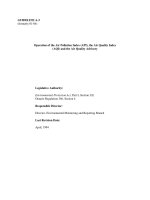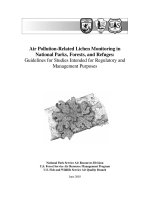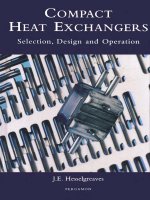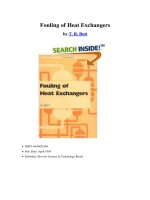EXH600 air cooled heat exchangers
Bạn đang xem bản rút gọn của tài liệu. Xem và tải ngay bản đầy đủ của tài liệu tại đây (38.17 KB, 4 trang )
600 Air Cooled Heat Exchangers
Abstract
This section provides general design guidelines for air cooled exchangers (also
called air coolers). See API Standard 661 for air cooler nomenclature and illustrations and for mechanical design requirements.
Chevron Corporation
Contents
Page
610
General Design Considerations
600-2
611
Design Air Temperature
612
Tube Side Design
613
Viscosity Plugging
614
Headers
615
Layout
620
Draft
600-3
630
Fans
600-4
640
Fins
600-4
650
Winterization
600-4
660
Estimating Rules of Thumb
600-4
600-1
December 1989
600 Air Cooled Heat Exchangers
Heat Exchanger and Cooling Tower Manual
610 General Design Considerations
Air cooled exchangers are used to cool or condense low viscosity fluids. They are
usually designed by the manufacturer. The HTRI ACE computer program may be
used to rate air coolers and condensers, if air rate is known. Fan design and rating is
beyond the scope of the ACE program.
611 Design Air Temperature
Design air temperature is usually selected as the dry bulb temperature that is
exceeded about 150 hours per year during the hottest 4 consecutive months. This
corresponds to meeting design performance 98+% of the year, but not for a few
hours a day during the hottest days.
Evaluated weather data can be obtained from the following sources:
•
“Evaluated Weather Data for Cooling Equipment Design,” by Fluor Products
Company, 1958.
•
“Army, Navy and Air Force Manual Engineering Data,” by Departments of the
Army, the Navy, and the Air Force, April 1, 1963.
•
“Evaluated Weather Data for Cooling Equipment Design, Addendum No. 1,
Winter and Summer,” by Fluor Products Company, 1964.
Consult ETD Engineering Analysis Division if these or other weather data sources
are not readily available.
Air cooling process streams to about 20°F over the design ambient temperature, or
higher, is economic. Water cooling or refrigeration is used if lower process temperatures are required.
612 Tube Side Design
Tube side design for air coolers and shell and tube exchangers involves the same
principles. Economic tube side velocities given in Section 220 and process side heat
transfer coefficient given in Section 481 apply to air coolers. Estimating rules of
thumb specific to air coolers are given in Section 660 below.
613 Viscosity Plugging
Cooling viscous fluids is usually not practical in air coolers because of viscosity
plugging. The viscosity of viscous oil usually increases rapidly with decreasing
temperature. Air side maldistribution inevitably causes some tubes to run cooler
than others. This increases the viscosity in the cooler tube and therefore reduces
flow through that tube, which causes further cooling and more flow reduction. The
result of this temperature-viscosity-flow effect is to virtually stop flow in some
tubes and force flowing tubes into the turbulent flow regime, if the viscous oil
pumps can develop the needed head. Otherwise, flow essentially stops.
December 1989
600-2
Chevron Corporation
Heat Exchanger and Cooling Tower Manual
600 Air Cooled Heat Exchangers
Air coolers should not be used when the tube side outlet Reynolds number (defined
in Appendix B) is less than 2000.
Air recirculation described in Section 650 may be used to air cool fluids that
become very viscous or freeze near ambient temperatures. Tempered water cooling
described in Section 330 is an alternative.
614 Headers
Most air coolers have header plugs opposite each tube on each end to facilitate
inspection and cleaning. Removable cover plates on each header is an alternative
but is not economic and rarely used.
615 Layout
Air-cooled exchangers usually have four rows of staggered tubes. Six rows are
sometimes used for large process temperature range. Aligned tube rows are never
advantageous because of significant air side channeling and temperature maldistribution.
Air-cooled exchangers are often mounted over pipeways to minimize plant real
estate. Pipeway mounted units are usually 30 feet long. Shorter bundles are
common for grade mounted units.
More than one bundle (service) may be in the same bay with a common pair of
fans, if overcooling some of the services is not a concern. If overcooling is a potential problem, adjustable louvers for that bundle can be used, or the service can be
built as a separate unit with dedicated fans.
620 Draft
Forced draft is required when the maximum outlet air temperature is higher than
the manufacturer’s rated temperature of the fans or the auto-variable fan pitch
control hubs. Operation with the fans off and during steam out should be considered. The air outlet temperature is approximately the same as the process inlet
temperature when fans are off, and same as the steam temperature during steam out.
The plenum of induced draft units acts like a stack and produces a significant “fansoff” duty. The “fans-off” performance of forced draft units is negligible.
Induced draft is sometimes specified for a column overhead condenser where
temperatures permit. Induced draft is normally considered if overcooling during
rain storms is a problem or if design relief loads would be reduced by the superior
fans off performance of induced draft units. Rain affects the full bundle in forced
draft units and only about half the bundle in induced draft units.
When the above considerations do not govern draft, the manufacturer usually
decides. Induced draft provides better air flow distribution than forced draft;
however, induced draft fans must move a greater volume of (heated) air than forced
draft. These effects are not large.
Chevron Corporation
600-3
December 1989
600 Air Cooled Heat Exchangers
Heat Exchanger and Cooling Tower Manual
630 Fans
There should be at least two fans per bundle with the fans covering at least 40
percent of the bundle. Half of the fans are usually autovariable pitch fans. During
the summer, the manual fan is on and the autovariable fan adjusts air flow to control
duty. During the winter, the manual fan is usually shut off. Auto-variable fan pitch
control is usually justified by fan power savings rather than control needs, but
serves both functions. Fan blades are usually aluminum or plastic. The best plastic
fan blades are good to about 350°F. Auto-variable fan pitch control hubs may have
rubber seals that limit temperature to about 250°F.
640 Fins
Fins are almost always aluminum. Three fin types are commonly used: footed, integral (extruded) and imbedded. Maximum process inlet temperatures for these fin
types are 250°F, 550°F, and 750°F, respectively. API 661, Section 5.1, describes
these fin types in more detail.
650 Winterization
Winterization is required for air coolers with fluids that may become immobile
under expected winter conditions due to freezing, pour point problems or the
viscosity plugging phenomenon described in Section 610. Winterization usually
means building an enclosure around the air cooler with provisions to recirculate a
portion of the outlet air back to the inlet. A steam coil under the bundle is also
normally provided to heat up the bundle if the fluid in the bundle ever becomes
immobile. Winterization of air coolers is discussed in detail in API Recommended
Practice 632 (not included in this manual).
660 Estimating Rules of Thumb
Air coolers usually have four layers of 1-inch O.D. tubes with 10, 5/8-inch high fins
per inch, arranged in a 2-1/2-inch pitch equilateral triangular layout. The ratio of fin
surface to bare outside surface (bos) is about 20:1; the required plot space is about
200 ft2 per 1000 ft2bos; the air rate is about 600 lb/hr/ft2bos; the installed fan power
is about 20 hp per 1000 ft2bos; and the air side heat transfer coefficient is about 175
Btu/hr ⋅ °F ⋅ ft2⋅bos .
Note that the installed fan power (“pumping power”) is four times higher than that
normally used for other types of heat exchangers. This is because air cooler design
is limited by warm weather operation. Annual average fan power is usually about
one fourth of the design value.
December 1989
600-4
Chevron Corporation









